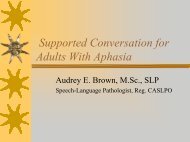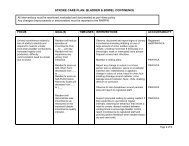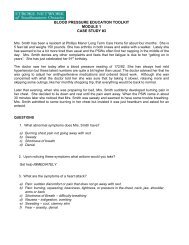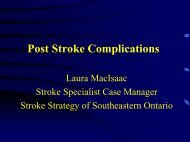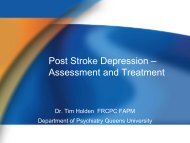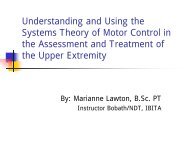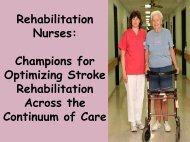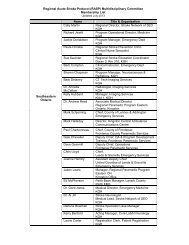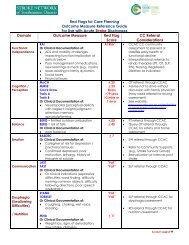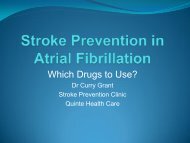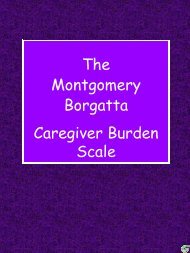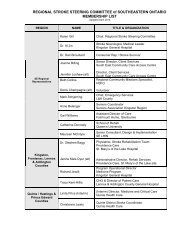Rehabilitation and Community Reintegration
Rehabilitation and Community Reintegration
Rehabilitation and Community Reintegration
- No tags were found...
Create successful ePaper yourself
Turn your PDF publications into a flip-book with our unique Google optimized e-Paper software.
BROCKVILLE BEST PRACTICE UPDATENovember 30 , 2011<strong>Rehabilitation</strong> <strong>and</strong><strong>Community</strong><strong>Reintegration</strong>Kathrine Stolee, MD
DISCLOSURE OF POTENTIAL FOR CONFLICT OFINTERESTKathrine Stolee MD FRCPCREHABILITATION & COMMUNITYREINTEGRATIONFINANCIAL DISCLOSURE:From pooled funds of theSoutheast Local HealthIntegration Network (LHIN)
OBJECTIVES:•Rehab considerations in varioussettings across the continuum of care•Measurement tools <strong>and</strong> what thescores mean•Tools <strong>and</strong> resources available•Best practice guidelines 2010
FORMAT: CASE STUDIES1. Emergency room2. Short stay on acute ward3. In patient rehabilitation4. Post discharge: family physician’soffice visit
CASE ONE: EMERGENCY ROOM• 76y male comes to ER 20h post a 6h episode of confusion,word finding difficulty <strong>and</strong> mild RUE weakness whichcompletely resolved. Hx of hypertension.• Neurological exam normal. MMSE 27• CT scan: Nil acute.Small lacunar infarcts in R IC <strong>and</strong> L BGMild to moderate cerebral <strong>and</strong>cerebellar atrophy, periventricularwhite matter chronic ischemic change• Initiate usual treatment with ASA, Ramapril <strong>and</strong> Crestor• Arrange holter, echo, carotid dopplers• Referral to VPC <strong>and</strong> follow up with own FP
BUT WAIT…..• On way out the door, wife mentions thathe has been forgetful over the last fewmonths.• Minor difficulty balancing the bank book.• WOULD YOU CHANGE YOURMANAGEMENT PLAN AT THIS POINT?
BEST PRACTICE RECOMMENDATION: 7.4• All patients with vascular risk factors <strong>and</strong> thosewith clinically evident stroke or TIA should beconsidered at high risk for VASCULAR COGNITIVEIMPAIRMENT (VCI)• RISKS INCLUDE:Neuroimaging findings of covert stroke <strong>and</strong> orwhite matter diseasePatients with cognitive or functional changesthat are clinically evident or reported duringhistory taking.
“CANARY IN A COAL MINE”•Covert stroke 10x overt stroke•More rapid cognitive decline•2x dementia•3x CVA•NOT BENIGN FINDING
MONTREAL COGNITIVE ASSESSMENT(MoCA)• More sensitive than MMSE to VCI• Frontal lobe subtests (executive function)• Sequencing, organizing, abstracting,planning• Score: 27-30 normal
RESOURSE AVAILABLE•Referral to CCAC OT for MoCA•Screening
CASE TWO: SHORT STAYACUTE WARD• 68y male lives alone• Admitted on a Thursday for work up of acutestroke syndrome; left sided weakness• CT scan confirms a small R MCA ischemic infarct• Appropriate treatment initiated, work upcompleted• Carotid dopplers confirm a high grade ICAstenosis• Vascular consult in 10 days arranged• Deficits appear to have resolved. Patient stateshe feels back to normal. Wants to go home
• It’s early Saturday morning, bed crunch inthe hospital• Plan: Discharge him home awaitingvascular consult.
BUT WAIT…..• Physiotherapy notes state he has a BERGof 40/56• Occupational therapy has done a quickreview: appears to be able to do hisADL’s independantly but wonders if he hassome left neglect.• Patient really wants to go home!!• WOULD YOU CHANGE YOURMANAGEMENT PLAN AT THIS POINT?
BEST PRACTICE RECOMMENDATION: 6.5• Stroke survivors should continue to haveaccess to specialized stroke services afterleaving hospital, whether from acute care orinpatient rehabilitation• EARLY SUPPORTED DISCHARGE PROGRAM(ESDP)• Successful ESDP-better patient outcome-reduced readmission rates
DISCHARGE LINK•Enhanced services funded <strong>and</strong>coordinated through CCAC•Collaborative care plan by casemanager•Multiple therapies at home for 2months: PT, OT, SLP, SW*•Home, retirement home, LTC
BERG BALANCE SCALE• 56 point scale to assess risk of falls• Score: 41-56 low riskunassisted21-40 moderate riskassistancegait aid
CASE THREE: IN PATIENT REHAB• 56y female on rehab service for 4 weeks.• Dense right hemiparesis-subcortical infarct so nolanguage or cognitive issues.• Family concerned that she is not working very hard.Ask about prognosis <strong>and</strong> discharge home. She hasa supportive spouse <strong>and</strong> children.• Rehab consultant on holidays
• Therapy notes: FIM: 50-70BERG: 11-18BASDEC: 11• WHAT SHOULD I SAY TO FAMILY?
FUNCTIONAL INDEPENDENCE MEASURE• Generic measure of disability• Assess physical <strong>and</strong> cognitive function in contextof relative burden of care• 6 domains: self-care, transfers,locomotion, sphincter control,communication <strong>and</strong> cognition• 18 items scored 1=dependent7=independentTotal=126
FIM SCORES: admission/acute•80: suitable for community oroutpatient rehab•Alpha-FIM
BERG SCALE•
BEST PRACTICE GUIDELINE: 7.3DEPRESSION•All stroke patients at high risk thereforeshould be screened for depression
BRIEF ASSESSMENT SCHEDULE DEPRESSION CARDBASDEC• To identify the presence of underlyingdepressive disorder• 19 questions with total score of 21• >7 suggests a depressive symptomsrequiring further investigation• True or false cards*
VOLUNTEER POST STROKESURVIVOR VISITING PROGRAM• New program beginning this week• In patients• Trained volunteers• Consent forms
CASE FOUR: POST STROKE FOLLOW-UPWITH FAMILY PHYSICIAN• Wife of a stroke survivor comes to see you3 months after husb<strong>and</strong>’s discharge fromhospital.• Tearful, exhaused, irritable, LBP• Wants to talk about placement.• Office very busy• IS THERE A QUICK FIX FOR THIS?
BEST PRACTICE GUIDELINE: 6.0MANAGING STROKE CARE TRANSITIONS• Stroke is life altering• Extended recovery period• Patient has ongoing functionalimpairments• Families <strong>and</strong> caregivers expected to takeon tasks <strong>and</strong> responsibilities that requireknowledge <strong>and</strong> skills that are beyond theirscope.
CAREGIVER’S ROLE•Meet physical dem<strong>and</strong>s of the survivor•Establish new routines of care•Support survivor’s attempts at communityre-integration•Care for themselves•Resume their valued activities•High risk of depression (60%)
RESOURCES•Screening questionnaires to assess howstroke survivor <strong>and</strong> caregiver aremanaging at home.•<strong>Community</strong> Resource Directory: servicesavailable in the area•Stroke Survivor <strong>and</strong> Caregiver SupportGroup
RESOURCES• Assessment <strong>and</strong> treatment of caregiverdepression• SW support through CCAC• Maximize respite (CCAC, day away )
QUESTIONS??



